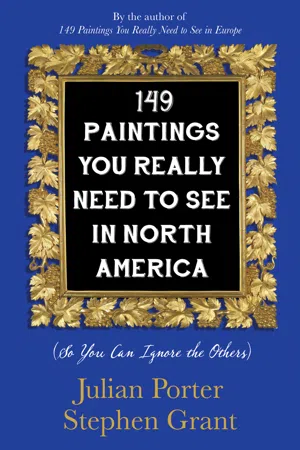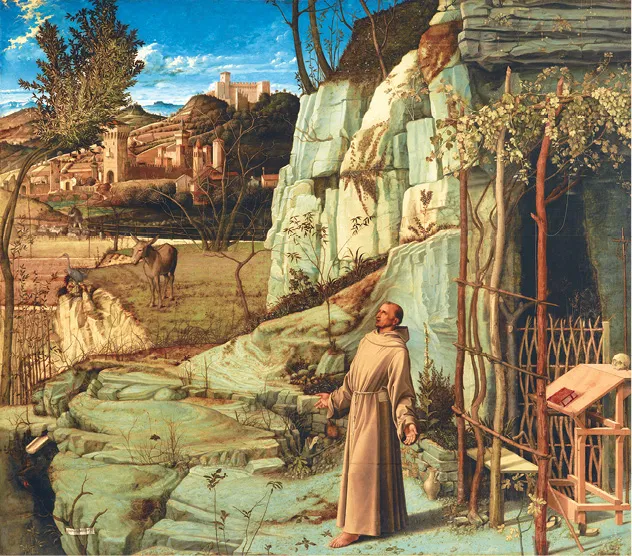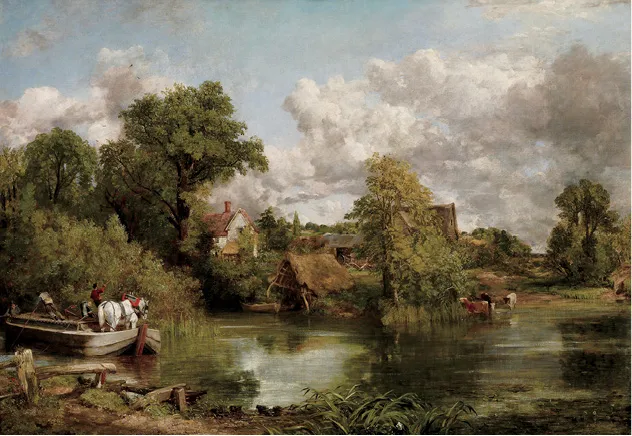Chapter 9
New York, New York
Frick Collection
One of the stately rooms in this mansion contains the greatest clutch of Renaissance European art in all of America. There, with an audio guide, you can sit on an elegant antique chair and look across at El Greco’s Saint Jerome . Nothing quite trumps this in the world of magnificent art rushes.
The Frick is special because it is a single-floored Roman sort of mansion at 70th and 5th Avenue in New York. In the middle, a courtyard with tinkling water and some roof light; on the side, Corots and a Vermeer. No matter which room you slip into, and it is a feeling of slipping with ease into a room, there are but a few people. I first went with my father, I was all of nineteen. How many times since? At least sixty.
Frick was once told by Duveen, the art dealer, that in his obituary his art would outstrip his own business history. He was a partner with Carnegie and had control over Pittsburgh Steel Mills (1892). They were living hells, caldrons of heat and clanging. Frick didn’t tolerate unions and called opponents communists. One “strike” was met with company violence. A battle took place at Homestead, Pennsylvania, with National Guardsmen that resulted in some deaths. Frick himself was shot.
He was a careful buyer and Gimpel noted his eyes, “But his cold eyes, grasping and hard under their genial look, remain a clear, beautiful blue.”1
Years later, I read Chambers Encyclopaedia ; as I remember it, on Frick there were eighty-three lines, and forty-three were about his collection: Rembrandt, Titian, Vermeer, and the rest marched to the front of his obituary.
All this the product of a bit of a fluffery magic salesman Duveen and a mean steel magnate. Go figure.
JP
47. St. Francis in the Desert (c. 1476–78)
Giovanni Bellini (1430–1516)
Giovanni Bellini, St. Francis in the Desert, c. 1476–78
Oil on panel, panel 124.6 x 142 cm; image 124.1 x 140.5 cm
Henry Clay Frick bequest (1915.1.03)
The Frick Collection, New York
© The Frick Collection
This painting by Giovanni Belllini is considered to be the greatest Renaissance painting in America. Perhaps. St. Francis in the Desert receiving the stigmata — the wounds of Christ’s crucifixion. A radiant light floods the canvas emphasizing all the details of rocks, plants, buildings, patterned and sculpted. One revels in the marble valley of nature. The light positions a city on the hill — a fortress.
The painting is almost Flemish in its realism. Francis has retreated to a cave to commune with nature. Bellini unites old and new testament themes to associate Francis with both Moses and Christ. The tree symbolizes the burning bush; the stream the miraculous spring struck forth by Moses; the grapevine and the stigmata Christ’s sacrifice; the crane and donkey the monastic virtue of patience. The golden light suffusing it all is Venice.
The very air in this serene pool of a painting is there to touch. It is not the air of a hot summer day, it is air caught in a bell jar, palpable. The lined rock formations mirror the substance of St. Francis’s belief — all solid. The distant town is a mini San Gimignano (the town of towers close to Florence), wealthy, walled, a medieval gated community. It stands as a backdrop to St. Francis in lovely intercourse with God.
It is a painting that demands an attentive audience. The ribbed variations of the rock behind and the actual small village in the translucent atmosphere, are as clear as a binocular vision.
Bellini was not a man who painted slaughters of the innocents or last judgments. A simple, gentle, idealistic style, but he opened the Pandora’s box for Titian, and what greater accolade could there be? He was the dean of Venice’s painters. Titian, a follower, and Durer, an invited performer.
Perhaps this is the moment St. Francis composed his hymn to the sun, which calls upon all nature, brother sun, and sister wind to praise their creator.
JP
48. The White Horse (1819)
John Constable (1776–1837)
John Constable, The White Horse, 1819
Oil on canvas (lined), 131.4 x 188.3 cm
Purchased 1943 (1943.1.147)
The Frick Collection, New York
© The Frick Collection
Down the hall is a John Constable, The White Horse (1819), as fresh and breezy as a post-sprinkle English spring day, all light, white paint, near cloud, the envy of the French and a guidebook for Delacroix. White paint tipping the river water in slabs, which caused criticism, known as Constable’s snow. Now it is viewed as a genius of impressionistic talent and imaginative flair. You are there at the River Stour, for a moment this is not a picture — it is a clear memory of you actually being there, cool gurgling water with the creak of the ferry barge.
What do you see?
Well, the barge pole man is all aheave. The bushes above with the white dots — daytime fireflies. The skitter white snow of a smear on the water (criticized by many English, applauded by Delacroix in Paris), the ramshackle thatched hut giving it a sense of nature not as tamed as an idyllic English countryside, past labour forgotten, future labour needed, ever thus in farming. Clouds to the far right, it’s sure to rain depending on the wind’s direction.
The White Horse was Constable’s first sale. He was desperate and this gave him his first reassurance. The purchaser was Archdeacon John Fisher of Salisbury Cathedral for £100. Constable later bought it back from Fisher in 1829 and kept it for the rest of his life. “There are generally in the life of an artist perhaps one, two or three pictures on which hang more than usual interest — this is mine.”
Constable did six “six-footers” (52 in x 74 in) — River Stour paintings that were the jewels of his career. This was his first. His method was novel — he did full-size oil sketches first to see how it would work out. “A large canvas will show you what you cannot do, a small one will only show you what you can.”
The “sketches” were done with a palette knife and impressionistic slash and blob. The sketch for this is in the Washington National Gallery. Check it out.
This was exhibited in 1819 and was instrumental to his being elected to the Royal Academy. He relied on inspiration from Dutch/Flemish landscape artists, with their calm river scenes. Two were Ruisdael and Rubens.
As you get older, you must choose with care what books you should read and what books you should read again. Years ago, I was influenced by Kenneth Clark’s Civilisation. I re-read it over a Christmas holiday. My, what a remarkable scope, a feast of intellect. He discusses the evolution of landscape painting. Around 1735 religion collapsed, leaving a vacuum, and over the next 100 years the concept of the divinity of nature surfaced. In 1760 Rousseau went to Switzerland and had a mystical experience with nature. He believed in the innocence and beauty of nature which extended to mankind. Wordsworth, who had been in France in 1793, wrote,
One impulse from a vernal wood
May teach you more of man,
Of moral evil and of good,
Than all the sages can.
Constable shared Wordsworth’s conviction that by dwelling with absolute truth on natural objects, he could reveal something of the moral grandeur of the universe.
Before then it didn’t occur to the ordinary traveller crossing the Alps to admire the scenery. Mountains were considered obstacles, a nuisance, and filled with bandits.
Clark observed that Constable’s love of the Stour Valley and its shiny posts and rotten banks was revolutionary at a time when all serious artists aspired to go to Rome and paint vast pictures of subjects from Homer and Plutarch...


